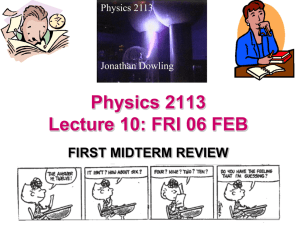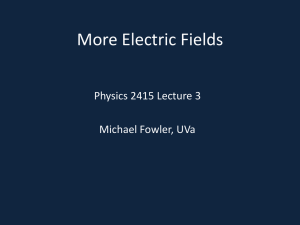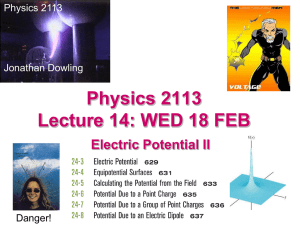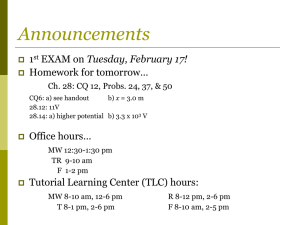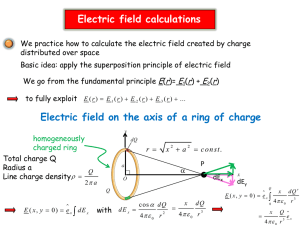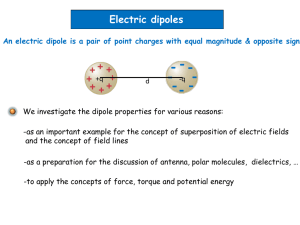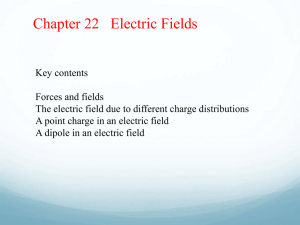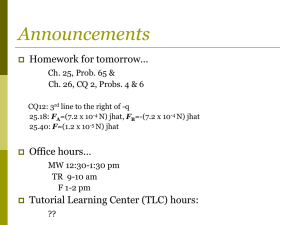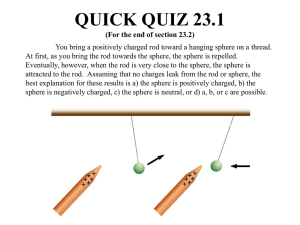PPT
advertisement
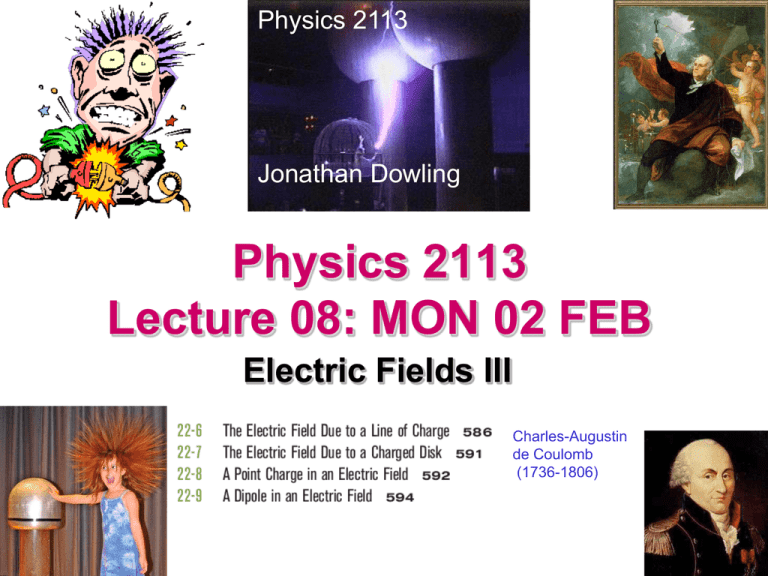
Physics 2113 Jonathan Dowling Physics 2113 Lecture 08: MON 02 FEB Electric Fields III Charles-Augustin de Coulomb (1736-1806) Electric Charges and Fields First: Given Electric Charges, We Calculate the Electric Field Using E=kqr/r3. Charge Produces EField Example: the Electric Field Produced By a Single Charge, or by a Dipole: Second: Given an Electric Field, We Calculate the Forces on Other Charges Using F=qE Examples: Forces on a Single Charge When Immersed in the Field of a Dipole, Torque on a Dipole When Immersed in an Uniform Electric Field. E-Field Then Produces Force on Another Charge Continuous Charge Distribution • Thus Far, We Have Only Dealt With Discrete, Point Charges. q • Imagine Instead That a Charge q Is Smeared Out Over A: q – LINE q – AREA – VOLUME • How to Compute the Electric Field E? Calculus!!! q Charge Density • Useful idea: charge density • Line of charge: charge per unit length = • Sheet of charge: = q/L = q/A charge per unit area = • Volume of charge: per unit volume = charge = q/V Computing Electric Field of Continuous Charge Distribution • Approach: Divide the Continuous Charge Distribution Into Infinitesimally Small Differential Elements dq • Treat Each Element As a POINT Charge & Compute Its Electric Field • Sum (Integrate) Over All Elements • Always Look for Symmetry to Simplify Calculation! dq = dL dq = dS dq = ρ dV Differential Form of Coulomb’s Law E-Field at Point q2 P1 Differential dE-Field at Point P1 P2 dq2 ICPP: Arc of Charge • Figure shows a uniformly charged rod of charge –Q bent into a circular arc of radius R, centered at (0,0). • What is the direction of the electric field at the origin? (a) Field is 0. (b) Along +y (c) Along -y y - - - - - - - - - - - x • Choose symmetric elements • x components cancel Arc of Charge: Quantitative • Figure shows a uniformly charged rod of charge –Q bent into a circular arc of radius R, centered at (0,0). • ICPP: Which way does net E-field point? • Compute the direction & magnitude of E at the origin. dEx = dE cosq = Ex = p /2 ò 0 kdq cosq 2 R k (lRdq ) cosq kl = 2 R R kl Ex = R y –Q 450 x dq = l Rdq y dq p /2 ò cosqdq q 0 kl kl Enet = 2 Ey = R R Q Q 2Q l= = = L 2p R / 4 p R E = Ex2 + Ey2 x (a) toward positive y; (b) toward positive x; (c) toward negative y Charged Ring The Electric to a Line Canceling22-4 Components - Point Field P is onDue the axis: In the of Charge Figure (right), consider the charge element on the opposite side of the ring. It too contributes the field magnitude dE but the field vector leans at angle θ in the opposite direction from the vector from our first charge element, as indicated in the side view of Figure (bottom). Thus the two perpendicular components cancel. All around the ring, this cancelation occurs for every charge element and its symmetric partner on the opposite side of the ring. So we can neglect all the perpendicular components. The components perpendicular to the z axis cancel; the parallel components add. A ring of uniform positive charge. A differential element of charge occupies a length ds (greatly exaggerated for clarity). This element sets up an electric field dE at point P. Charged Ring 22-4 The Electric Field Due to a Line of Charge Adding Components. From the figure (bottom), we see that the parallel components each have magnitude dE cosθ. We can replace cosθ by using the right triangle in the Figure (right) to write The components perpendicular to the z axis cancel; the parallel components add. A ring of uniform positive charge. A differential element of charge occupies a length ds (greatly exaggerated for clarity). This element sets up an electric field dE at point P. Charged Ring 22-4 The Electric Field Due to a Line of Charge Integrating. Because we must sum a huge number of these components, each small, we set up an integral that moves along the ring, from element to element, from a starting point (call it s=0) through the full circumference (s=2πR). Only the quantity s varies as we go through the elements. We find Finally, The components perpendicular to the z axis cancel; the parallel components add. A ring of uniform positive charge. A differential element of charge occupies a length ds (greatly exaggerated for clarity). This element sets up an electric field dE at point P. ICPP: Field on Axis of Charged Disk • A uniformly charged circular disk (with positive charge) • What is the direction of E at point P on the axis? + + z + + + + + + + + + (a) Field is 0 (b) Along +z (c) Somewhere in the x-y plane P y x Charged Disk is Integral of Charged Rings Taking R ® ¥ gives E field above an infinite charged plane: s Eplane = 2e 0 Q s= p R2 dq = s dA = s 2p rdr A disk of radius R and uniform positive charge. The ring shown has radius r and radial width dr. It sets up a differential electric field dE at point P on its central axis. Force on a Charge in Electric Field Definition of Electric Field: Force on Charge Due to Electric Field: Force on a Charge in Electric Field +++++++++ E –––––––––– Positive Charge Force in Same Direction as EField (Follows) +++++++++ E –––––––––– Negative Charge Force in Opposite Direction as EField (Opposes) (a) left (b) left - - (c) decrease Electric Dipole in a Uniform Field • Net force on dipole = 0; center of mass stays where it is. • Net TORQUE : INTO page. Dipole rotates to line up in direction of E. • | | = 2(qE)(d/2)(sin q) = (qd)(E)sinq = |p| E sinq = |p x E| • The dipole tends to “align” itself with the field lines. • ICPP: What happens if the field is NOT UNIFORM?? Distance Between Charges = d - p = qd - + + - - - Electric Dipole in a Uniform Field • Net force on dipole = 0; center of mass stays where it is. • Potential Energy U is smallest when p is aligned with E and largest when p anti-aligned with E. • The dipole tends to “align” itself with the field lines. U = - pE cos0° = - pE U = - pE cos180° = + pE Distance Between Charges = d - 1 and 3 are “uphill”. 2 and 4 are “downhill”. U1 = U3 > U2 = U4 U1 = - pE cos (135°) == +0.71pE U2 = - pE cos ( +45°) == -0.71pE - = 45° U3 = - pE cos ( -135°) == +0.71pE - U4 = - pE cos ( -45°) == -0.71pE t 1 = pE sin ( 45° + 45° + 45°) = pE sin (135°) = 0.71pE t 2 = pE sin ( 45°) = 0.71pE t 3 = pE sin ( -135°) = 0.71pE t 4 = pE sin ( -45°) = 0.71pE t1 = t 2 = t 3 = t 4 (a) all tie; (b) 1 and 3 tie, then 2 and 4 tie Summary • The electric field produced by a system of charges at any point in space is the force per unit charge they produce at that point. • We can draw field lines to visualize the electric field produced by electric charges. • Electric field of a point charge: E=kq/r2 • Electric field of a dipole: E~kp/r3 • An electric dipole in an electric field rotates to align itself with the field. • Use CALCULUS to find E-field from a continuous charge distribution.
